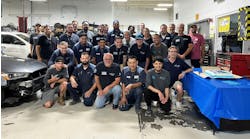To accomplish this objective, a manager must be alert to many operations and processes, and if you were to ask 100 collision repair managers what their main concern was in managing a collision repair shop, you would probably get between 90 and 100 different answers! It is safe to say, though, that either at or near the top of the list would be this goal: making a reasonable profit in the paint department. If a manager is to produce 35 percent to 38 percent of the total labor sales from the refinish department, he or she cannot afford to not get paid fully for what is done.
In order for a shop to maintain a high level of profit, there are many areas that must be managed properly. One of the most important is at the beginning, when the estimate is produced. Others are areas such as production management, changing equipment and its maintenance, production tracking and assessment, and of course, attracting and keeping a satisfied customer base.
Though these may not seem to be so great a list of tasks, it must be kept in mind that the collision repair industry is one of the most rapidly changing service industries. In fact, the only thing that can be counted on to be the same is that it is always changing. The industry can always expect new and different types of finish on vehicles, as well as new and different types of aftermarket coatings and materials, new procedures or methods of application or curing, new equipment, and even new environmental regulations. A shop manager must be aware of the changes and how they affect the business and profits.
The estimate
The estimate is the first step of the repair process, and it is where a shop can and must be thorough, because it is also where the profit can be made or lost. Though it is an oversimplification to say “write a good sheet,” it is one of the most important parts of the repair process. Knowing how to prepare a damage analysis or estimate, and understanding what tools are used to do so, is extremely important.
Estimators must be thorough and specific when they write each estimate. Whether an estimate is written by hand with manuals or with one of the many computerized estimating programs, knowing what is included in each procedure will allow the writer to be specific and list the entire task necessary, which may not be included in the manual. Consider a few examples: If an estimate is written to blend into the adjacent door panel and the blending procedure does not have de-trimming as an included item in that procedure, it should be added separately. If the procedure for the shop is to make a spray-out panel for each refinish repair, that procedure should be specifically listed. If a used part is received, the cleaning and preparation for use also should be listed.
When moldings are removed for refinishing and the plastic clips are removed, the cost of replacement clips should be added to the estimate. Moldings that are attached with adhesive should be removed, the residue adhesive should be cleaned, and new adhesive should be attached for re-installation.
Many fasteners are single-use or are destroyed when removed, and that cost should be added to the estimate or the supplement. Many shops have computerized programs in their parts department, which can bill fasteners, supplies, and other items to each repair order, therefore insuring getting paid for items that are overlooked on many estimates.
To write a thorough estimate, estimators must know each repair procedure, and the repair technician should perform each procedure the same way. For a shop to do this, it should have written standard operations procedures (SOPs). SOPs help ensure that each repair is performed in the same way and to the same quality, and it also helps speed up cycle time in the shop by avoiding the dreaded “20-minute questions” (see sidebar, “The 20-minute question”). Supplies needed for a repair can be ready and available as the work progresses through the shop. Supplies also can be ready and available for technicians on time, and tracking of the vehicles can be more precise. The estimator can follow the vehicle through the shop and keep the customer informed.
The estimating process
SOPs should extend through the steps of the estimating and repair process: after the initial estimate is written, insurer approved, parts ordered and received, and the vehicle is scheduled for repair. Following the breakdown, if a supplement is needed, the paint department should be considered and written for as well. If a repair is extended and additional repairs are needed, refinish changes should be included.
As the vehicle goes through the repair process, the owner should be kept informed. Not getting a vehicle when promised continues to be one of the top complaints in the industry. However, if the customer is kept informed as the vehicle is progressing through the repair process, it will be less likely that he or she will be surprised and disappointed by a late delivery. Customers should be alerted when the supplement parts have arrived and the repair is underway, when the vehicle is out of metal repair and ready for paint, and when the repair is completed and a delivery date is set.
Procedure efficiency
Procedure efficiency should always be on the mind of shop managers. In successful shops, ways to improve a process and thus make it more profitable are always being considered. Some of these processes have a learning curve and may need to be considered carefully; the technicians should be trained before a process is rejected. For example, roll priming in the body shop before a repaired vehicle gets to the paint shop has been rejected by some technicians. They say, “I tried it once and it didn’t work.” True, rolling primer takes some practice in order not to have runs or heavy texture, but the time-saving advantages outweigh the practice time needed to perfect the process.
Painting parts off the vehicle, then installing them after, is another frequent complaint of body technicians, because it is new and they believe that it costs them time when installing. But the time saved in the paint shop by just reducing the number of times paint needs to be prepared, and the reduction of material costs, also outweighs the time spent learning this new process.
Equipment changes
Though new equipment, or for that matter new processes, are not ways to “get paid for what we do,” they do increase productivity and therefore profit. While not all new processes or equipment are worth buying, there are some that will increase productivity and quickly reimburse a business for their cost. Plastic covering for vehicles is an example. Once a vehicle surface is prepared, the vehicle is cleaned and only a limited amount of masking is performed, the vehicle can be placed in a booth and “bagged” in a fraction of the time that it once took to properly mask a vehicle. Liquid mask in areas that it is difficult to clean before painting, such as wheel wells, also speeds up the vehicle prep and detailing processes.
DAs that have different orbits now help us do some processes with a capable machine that once needed to be done by hand. UV and infrared lights speed up the priming and curing process and hyper-cure clears that can be baked for short times speed up the time needed in a very expensive paint booth. Now spraying and curing 10 or more vehicles in one booth is easily feasible.
Disposable plastic cups for spray guns that can be used to mix the precise amount of coating needed for a job (thus eliminating metal containers, waste, and significantly reducing the cost of both time and solvent during clean-up) also have allowed us to increase our productivity and profits.
New and improved tools, materials and equipment are constantly being produced and marketed to us, and it seems as though it is a continuing struggle to evaluate their usefulness to each shop’s needs. Not all should be adopted, but we should keep an open mind and constantly evaluate procedures and processes if our paint departments are to remain productive and profitable.
Honesty
Though it is mentioned late in this discussion, honesty is one thing that should be constantly on our minds. The core values, or unchangeable values, of a business go a long way towards affecting profitability and ensuring that we “get paid for what we do.” Business values such as service, honesty, quality, efficiency, appearance and profit will aid in our being respected by both of our customers: our primary customer, the vehicle owner; and our secondary customer, the insurance provider. They both must know that if we write to sand and buff a vehicle—and in the end that procedure is not needed—it will be removed from the final bill. They also will know that when we de-trim a vehicle, we de-trim it all, every time. A business’s integrity is easily lost and hard, if not impossible, to regain once it is lost. Like many other items, though it does not directly affect how we get paid every time, honesty in business impacts how we get paid in the long term.
Getting paid
So how do we get paid for what we do? We write specifically for every procedure that we do. We know what is an included item, and those things that are not in the P-Pages as included we write and charge for. We review and note items that are often forgotten during the estimating process, such as not listing for new clips, or for cleaning and restoring adhesive on removed and reinstalled trim. When we write a supplement, we make sure that all items are included: paint, body, parts, and materials. We provide SOPs for our employees. We keep our customers informed throughout the repair process. We evaluate and adopt, when profitable, new equipment and processes, and we give our technicians training for these new processes. Above all, we establish core values: things that we will not compromise on—items that will help in all discussion processes for all from the principal CEO to the technicians.
Getting paid for what we do is, and will be, an ever-changing process. As each business changes and improves with the market, managers must look for those items or processes that will help their business make a reasonable profit.



